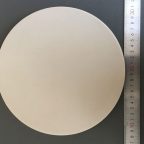
There are many methods for surface metallization of industrial ceramic substrates. The co-firing method is introduced above. Through high temperature or low temperature co-firing, the performance of zirconia ceramics and alumina ceramic substrates is enhanced and more beautiful. Next, Pintejin Ceramics will continue to introduce the surface metallization of thick film method.
The thick film method refers to the production process in which the conductive paste is directly coated on the ceramic substrate by screen printing, and then sintered at high temperature to make the metal layer firmly attached to the ceramic substrate. The choice of thick film conductor paste is a key factor in determining the thick film process, which consists of functional phase (ie metal powder, particle size within 2μm), binding phase (binder) and organic carrier.
Alumina ceramic sheet punching functional phase metal powder is generally Au, Pt, Au/Pt, Au/Pd, Ag, Ag/Pt, Ag/Pd, Cu, Ni, Al and W and other metals, among which Ag, Ag/Pd and Cu slurry in the majority. The binder is generally glass frit or metal oxide or a mixture of the two. Its function is to connect the ceramic and the metal and determine the adhesion of the thick film paste to the base ceramic, which is the key to the production of the thick film paste. The function of the organic carrier is mainly to disperse the functional phase and the binding phase, while maintaining a certain viscosity of the thick film paste to prepare for the subsequent screen printing, which will gradually volatilize during the sintering process. At present, the research on aluminum oxide thick film electronic paste has become mature, while aluminum nitride thick film electronic paste still has a large space for development.
Pintejin machining ceramic service include : Alumina Ceramic Parts, Zirconia Ceramic, Silicon Carbide Ceramic, CNC Machined Aluminum Nitride Ceramic, Machinable Ceramic Parts, Glass Ceramic,Macor Ceramic,Powder Metallurgy Dies,Ceramic Injection Molding,Ceramic Dry Pressing,Ceramic Extrusion Dies




